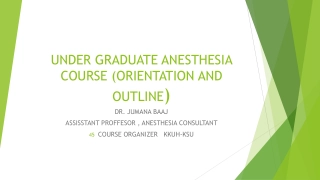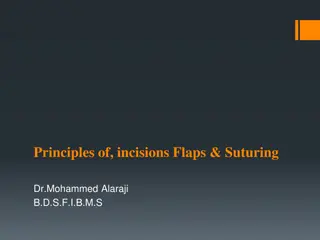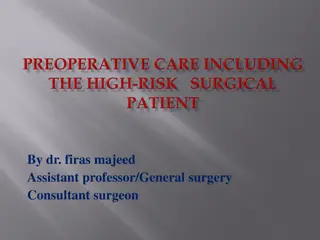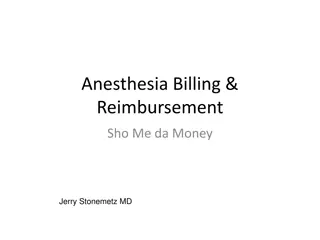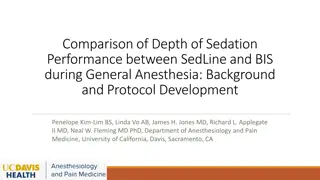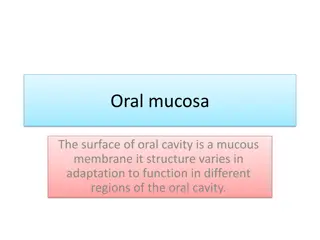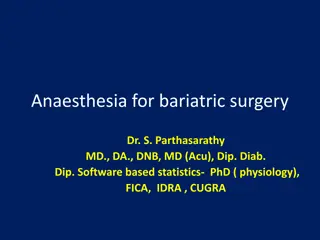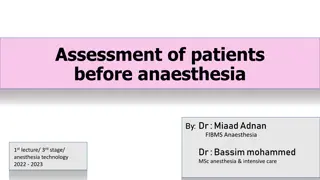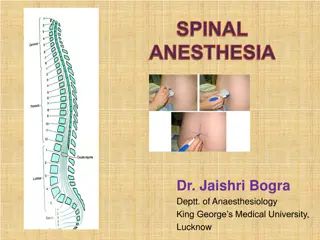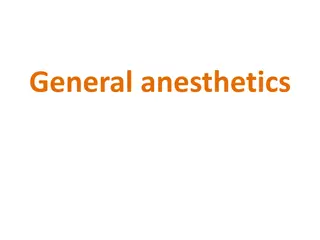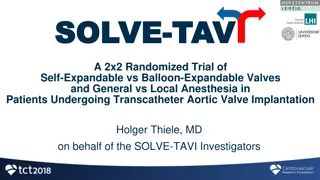Overview of Anesthesia in Oral Surgery: Local and General Anesthesia
Anesthesia in oral surgery involves local and general anesthesia, with discussions on indications, contraindications, premedication principles, complications, treatment, prevention, and cardiopulmonary resuscitation. The history of anesthesia in dentistry, from the use of cocaine in 1879 to the development of Novocain in 1904, is highlighted. Different methods of achieving anesthesia, such as physical and chemico-physical approaches, including acupuncture, are examined to provide pain relief during invasive procedures.
Download Presentation

Please find below an Image/Link to download the presentation.
The content on the website is provided AS IS for your information and personal use only. It may not be sold, licensed, or shared on other websites without obtaining consent from the author. Download presentation by click this link. If you encounter any issues during the download, it is possible that the publisher has removed the file from their server.
E N D
Presentation Transcript
ODESSA NATIONAL MEDICAL UNIVERSITY DEPARTMENT OF ORAL AND MAXILLOFACIAL SURGERY Lecture 1 Anesthesia in oral surgery. Local and general anesthesia. Indications and contraindications for anesthesia, premedication principles. Complication of local and general anesthesia, treatment and prevention. Cardiopulmonary resuscitation. Year 3 Professor Anatoliy G. Gulyuk
Visiting a dentist is traditionally associated with inescapable pain and fear of it. This tendency is still alive, in spite of a centuries-old tradition of anesthesia and its modern opportunities.
A pioneer in local anesthesia in dentistry was a Russian dentist V. Anrep, who in 1879 used cocaine not only for applicational, but also for injectional anesthesia, which turned out to be not absolutely safe for the organism. With discovery and introduction of Novocain in 1904 by a German scientist Eichhorn, a new era of solving tasks of painless surgery began. During nearly 100 years this anesthetic was a model for developing new medications now counting more than 100 items. A great role in developing and founding methods of local anesthesia was played by A.V. Vishnevsky, M.D. Dubov, S.N. Vaisblat, S.F. Grishchuk, P.A. Egorov etc.
Local anesthesia is defined as reversible breach of conductivity of impulses along nervous fibers, achieved by physical, chemical, of physico-chemical methods aimed at elimination of pain in the region of planned invasion not accompanied by loss of consciousness.
Physical methods, restrictedly used in maxillofacial surgery, include local cooling of a limited region of the tissue. It is achieved by using ice, liquid C02-dry ice mixture or quickly evaporating chemical agent, namely chlorethyl.
To chemico-physical methods can be referred electro-, electromagnetic, laser and audioanalgesia, when electric current, radiation or sound waves cause respective biochemical processes in tissues. In this category falls achieving anesthesia by means of acupuncture.
For local anesthesia now more than 100 agents are introduced which mainly fall. into, two chemical groups derivatives of benzoic acid - main representative being Novocain, and amid acid which is more common today - lidocaine, xylocaine, ultracaine etc, non- containing or containing vasoconstrictors, to increase duration of anesthesia.
According to methods of application of local anesthesia, there are two ways depending on using an anesthetic. 1. application of it onto the surface of the skin, mucosa, wound or ulcer surface, i.e. applicational anesthesia 2. injection of the solution of anesthetic into tissues: subcutaneously, into subcutaneous cellulose, muscles, into aponeurotic spaces and submucal capsule, into cellulous spaces, subperiosteously, intraosseously, peri- and endoneurally, i.e. injectional (infiltrational) anesthesia.
Applicational anesthesia is rarely used in surgery, mainly to eliminate painful irritation in open burning wounds, erosions, ulcers of mucosa, often as aerosols containing trimecaine (2% solution) etc. Sometimes applicational anesthesia is used for analgesia; of mucosa prior to injection (perylene-ultra, xylonor).
Injectional (infiltrational) anesthesia is the main method of local anesthesia in surgery on the face, jaws, oral cavity and other regions of the human body.
Another option to achieve anesthesia is introducing an anesthetic directly to the nerve stem or nerve plexus innervating particular area, namely conductional or regional anesthesia. Depending on the area of introducing an anesthetic, central anesthesia, predominantly near the place of exit of the nerve stem from the cranial cavity, and peripheral conductional anesthesia in areas innervating certain nerve conductors are differentiated.
At the same time, peripheral conductional anesthesia is widely used for surgery in the oral cavity, especially for extraction of mandibular molars and premolars.
With so many local anesthetic combinations available for injection, it becomes difficult to select an ideal drug for a given patient. Many dentists deal with this by simply using one local anesthetic for all procedures, regardless of their duration.
A first approach to the selection of a local anesthetic for a patient includes a consideration of the length of time for which pain control Is required. Table 4-5 lists the commonly used anesthetics according to their usual duration of anesthesia. The average, expected duration of pulpal and soft tissue anesthesia is listed. Again, take note, these numbers are approximations, and the actual duration of clinical anesthesia may be somewhat longer or shorter than indicated.
A second consideration in the selection of a local anesthetic must be the requirement for pain control following treatment. Long-duration anesthetics can be administered when postoperative pain is thought to be a factor. Drugs providing a shorter duration of soft tissue anesthesia can be used for nontraumatic procedures
A third factor is the need for hemostasis during the procedure. Anesthetic solutions containing epinephrine in a 1:50,000 or 1:100.000 dilution is recommended, via local infiltration, when hamostasis is considered necessary. A fourth factor in the selection of a local anesthetic involves the physical status of the patient. Table 4-6 lists contraindications for local anesthetics based on this criterion.
Absolute contraindications require that the offending drug(s) not he administered to the patient under any condition. The risk that a life-threatening situation will arise is increased. One absolute contraindication to local anesthetic administration exists: documented reproducible allergy. Fortunately this is an extremely rare occurrence, although the incidence of alleged local anesthetic allergy is quite high.
In cases of a relative contraindication it is preferable to avoid administration of the drug in question because of an increased risk that an adverse response will develop. An alternative drug that is not contraindicated is recommended.
Infiltrational, local anesthesia in maxilla: infraorbital anesthesia (extraoral and intraoral technique), incisal anesthesia (extraoral and intraoral technique). Possible complications and prevention in children and adults
There are several general methods of obtaining pain control with local anesthetics. The site of deposition of the drug relative to the area of operative intervention determines the type of injection administered. Three major types of local anesthetic injection can be differentiated local infiltration, field block, and nerve block.
Local infiltration Small terminal nerve endings in the area of the dental treatment are flooded with local anesthetic solution. Incision (or treatment) is then made into the same area in which the solution has been deposited . An example of local infiltration would be the administration of a local anesthetic into an interproximal papilla prior to root planing
Field block Local anesthetic solution is deposited near the larger terminal nerve branches so the anesthetized area will be circumscribed, to prevent the passage of impulses from the tooth to the central nervous system (CNS). Incision (or treatment) is then made into an area away from the site of injection of the anesthetic . Maxillary injections administered above the apex of the- tooth to be treated arc properly termed field blocks (although common usage identifies them as infiltration or supraperiosteal).
Nerve block Local anesthetic is deposited close to a main nerve trunk, usually at a distance from the site of operative intervention . Posterior superior alveolar. inferior alveolar, and nasopalatine injections are examples of nerve blocks
A number of injection techniques are available to aid in providing clinically adequate anesthesia of the teeth and soft and hard tissues in the maxilla. Selection of the specific technique to be used is determined, in large part, by the nature of the treatment to be provided. The available techniques are as follows:
Supraperiosteal (infiltration), recommended for limited treatment protocols Periodontal ligament (PDL, intraligamentary) Injection, recommended as an adjunct to other techniques or for limited treatment protocols Intraseptal injection, recommended primarily for periodontal surgical techniques
Intraosseous injection, rccommended for single teeth (primarily mandibular molars) when other techniques have failed Posterior superior alveolar nerve block, recom mended for management of several molar teeth in one quadrant Middle superior alveolar nerve block, recommend ed for management of premolars in one quadrant Anterior superior alveolar (infraorbital) nerve block, recommended for management of anterior teeth in one quadrant
Maxillary (second division) nrve block, recommended for extensive buccal, palatal, and pulpal management in one quadrant Greater (anterior) palatine nerve block, recommended for palatal soft and osseous tissue treatment distal to the canine in one quadrant Nasopalatine nerve block, recommended for palatal soft and osseous tissue management from canine to canine bilaterally
Supraperiosteal Injection Indications Pulpal anesthesia of the maxillary teeth when treatment is limited to one or two teeth Soft tissue anesthesia when indicated for surgical procedures in a circumscribed area Contraindications Infection or acute inflammation in the area of injection. Dense bone covering the apices of teeth can be determined only by trial and error;
Technique 1. A 25- or 27-gauge short needle recommended 2. Area of insertion: height of the mucobuccal fold above the apex of the tooth to be anesthetized 3. Target area: apical region of the tooth to be anesthetized
Anterior Superior Alveolar Nerve Block (Infraorbital Nerve Block) The anterior superior alveolar (ASA) nerve block does not enjoy the popularity of the PSA block, primarily because there is a general lack of experience with this highly successful and extremely safe technique. It provides profound pulpal and buccal soft tissue anesthesia from the maxillary central incisor through the premolars in about 72% of patients.
Used in place of supraperiosteal injections, the ASA nerve block requires a smaller volume of local anesthetic solution to achieve equivalent anesthesia 0.9 to 1.2 ml versus 3.0 ml lor supraperiosteal injections of the same teeth. Fortunately this fear is unfounded. Adherence to the following protocol will produce a high success rate devoid of complications and adverse side effects
Serves anesthetized Anterior superior alveolar Middle superior alveolar Infraorbital nerve Inferior palpebral lateral nasal Superior labial
Areas anesthetized Pulps of the maxillary central incisor through the canine on the injected side In about 72% of patients, pulps of the maxillary pre- molars and mesiobuccal root of the first molar Buccal (labial) periodontium and bone of these same teeth lower eyelid, lateral aspect of the nose, upper lip
Indications Dental procedures involving more than two maxillary' teeth and their overlying buccal tissues Inflammation or infection (which contraindicates supraperiosteal injection); if a cellulitis is present, the maxillary nerve block may be indicated in lieu of the infraorbital nerve block When supraperiosteal injections have been ineffective because of dense cortical bone
Contraindications Discrete treatment areas (one or two teeth only supraperiosteal preferred) Hemostasis of localized areas, when desirable, cannot be adequately achieved with this injection; local infiltration into the treatment area is indicated


